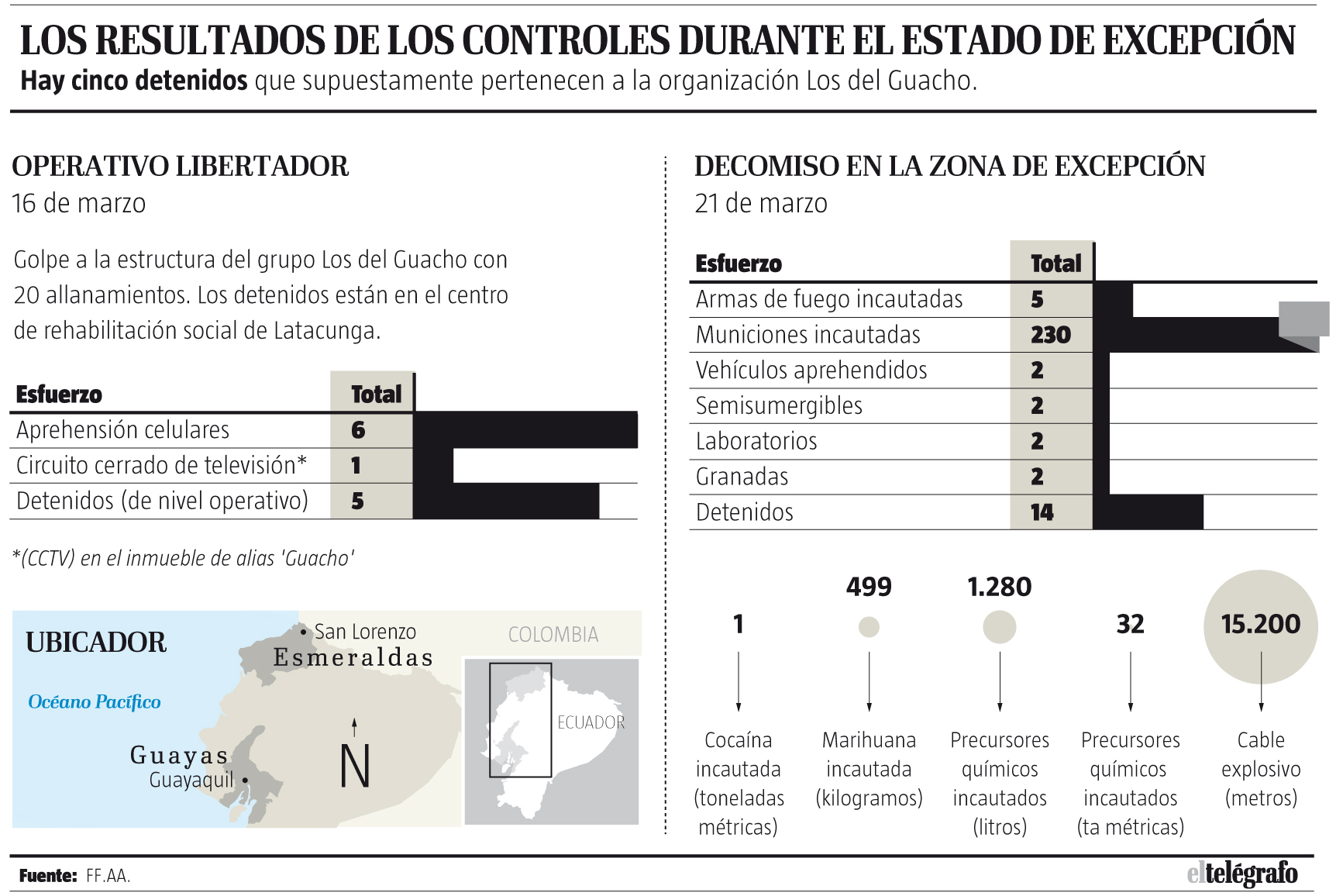Seven narco-guerrillas operate at the border
Ecuadornews:
The Army detected a resting base for the armed groups in the Manzayá sector, in Putumayo, province of Sucumbíos, the second one found so far this year in that area. Seizures of drugs and substances for the refinement of narcotics are permanent in the binational limit. In Esmeraldas there is concern about false bomb alarms. Authorities ask citizens to inform themselves by official sources and follow safety regulations.
The Heller Mosquera Front signed its last communique on January 18 of this year. He did it from the mountains of Colombia and Ecuador, as evidenced in the documents hidden in a cavern dug in a resting post erected in the middle of the jungle in the Manzayá sector, in Putumayo, province of Sucumbíos. This front is part of the groups that belonged to the guerrilla of the Revolutionary Armed Forces of Colombia (FARC) and that did not accept to leave the arms after the pact of peace.
Operative on four fronts
The Ecuadorian Army took control of this clandestine base on March 26. They did it after an intelligence job on the border line that lasted for weeks. The head of the Putumayo Battalion Carlos Ayala reported that they had the suspicion that the dissidents now known as organized armed groups (GAOS) operated from there.
The operation to find them was to be executed with pinpoint precision because the Commander of the Army, General Édison Narváez, participated in the action and journalists from national media were to be included. The security was maximum. They all had to put on bulletproof vests, combat helmets and green and black paint on their faces to hide in the jungle.
The operation was planned from four fronts: by the San Miguel River with speedboats and artillery; by air with combat helicopters; by surveillance of drones and by terrestrial routes to avoid the escape of the suspects. The tour of the San Miguel River from the Putumayo Battalion to the clandestine base lasted 45 minutes and passed through the towns of Puerto El Carmen and Puerto Asís, located on the border between Ecuador and Colombia. Upon reaching the sector of Manzayá, Army commandos took control of the beach and activated smoke grenades so that the helicopters could be guided to the area.
From the aircraft another patrol of soldiers descended and went into the jungle to support and protect the reporters and the authorities. The tour lasted an hour. The passage was slow and stealthy. The military alerted when they encountered a trap made with logs, a gas tank or anything that could put the security of the operation at risk.
Upon arrival, the base was abandoned, but there was evidence that not two hours had passed since the dissidents left the place. The head of the Army, Édison Narváez, calculated that time. The tests were a half-smoked cigarette, with the cigarette butt that did not fall to the ground yet; decks left to the trouble; Half-cooked food; and bandages to heal a person with wounds.
This base had four huts made of logs and military cloth: two were for rest with improvised beds with trees in the area; another for the care of injured people; a third to store food, canned goods, eggs, cookies, coffee, sugar and salt; and another space with a two-burner gas reverberator, where they cooked noodles and green plantains. Here they found a cove with the communique of the Heller Mosquera Front, where they told the “comuneros” of the area that they were going to request their economic collaboration in exchange for security. The head of the Battalion Putumayo, Carlos Ayala, said that the farmers of the area denounced these extortions. He described these dissident groups of the FARC as “narco-guerrillas” and “extremely dangerous.”
‘Gaucho’, the drug and the border
So far in 2018, the Battalion has seized half a ton of drugs; more than a thousand gallons of gasoline, diesel and white gasoline to refine narcotics. He also found another clandestine base. Intelligence reports show that at least seven groups dedicated to drug trafficking operate on the international border that reaches 740 kilometers.
On the side of Sucumbíos is the Heller Mosquera Front, which was part of the 48th Front of the FARC. The most sensitive areas of its operations are El Ají, La Bermeja, El Conejo, General Farfán; Puerto Nuevo Angostura; Puerto El Carmen and Tres Frontera. In the Colombian department of Nariño, which borders Esmeraldas, Carchi and Sucumbíos, there is the highest density of GAOS.
There have been identified six, which are the Gulf Clan, the Óliver Simistierra Front, Guerrillas Unidas del Pacifico, Peasant Resistance, People of Order and The Company. There is also the Heller Mosquera Front; altogether they add seven. All these bands are made up of ex-guerrillas and are responsible for the drug that leaves from Ecuador to markets in the north of the continent and Europe.
The one of greater notoriety is the Óliver Simistierra Front, directed by alias ‘Guacho’, also called Wálter Patricio Arizala or William Quiñónez, who is until now the main suspect of the car bomb attack in the police station of San Lorenzo; of the bomb at the Navy checkpoint in Borbón; the bomb that killed three sailors in Mataje; and the kidnapping of three El Comercio communicators. His name has always been linked to violence and drug trafficking.
‘Guacho’ was born 27 years ago in Limones, rural area of San Lorenzo. Since 2007 and for more than 10 years he was in the 29th Front and the Daniel Aldana Brigade of the FARC. In this irregular group he worked as financial chief and explosives expert, but after the peace agreement he decided to operate outside the law. His departure from the FARC was not ideological, he became one of the drug lords in that area. This position was achieved after the arrest of Pedro Álava, alias ‘Gerald’, one of the most wanted drug traffickers of recent years and who is now in the United States, where he will be tried.
‘Guacho’ operated under the orders of Álava, who is also Ecuadorian. That organization used the border rivers of Esmeraldas to transport the refined drug in laboratories of Tumaco.
Information
The military preparation
The training of the troops and officers of the Army is permanent. They must pass the survival course in the jungle. At this moment, more than 100 soldiers are in El Coca following this exhaustive preparation.
61 days have passed since the first attack occurred at the police station in San Lorenzo.
The State of exception
The executive decree was signed on January 27 and can be extended. State of exception applies to San Lorenzo and Eloy Alfaro.
Eloy Alfaro joined the restriction schedules
The canton Eloy Alfaro, another of the Esmeraldean jurisdictions where the state of emergency applies, joined yesterday to the restriction to enter their parishes from 10pm to 5am. A limit was also set for the attention in the night entertainment centers until 22:00. These measures started in San Lorenzo since last Monday and there have been no problems with the people who live in the parishes.
The Single Command of the Armed Forces and the Police stated that it was also necessary to apply this control in Eloy Alfaro, where there are areas considered sensitive and where organized armed groups (GAOS) have influence. These are Borbón, Selva Alegre and Limones; of this last one comes from Walter Patricio Arizala or William Quiñónez, better known as ‘Guacho’.
The mayor of Eloy Alfaro, José Francisco Ayoví, said that the entities of the municipal government and the Emergency Committee will coordinate together with the public force the controls on the access roads to the parishes. He said that this measure is also essential to give more security to the citizens of the area.
The authorities of the canton also made an order for citizens to inform themselves through official channels. Last Tuesday, for example, the news of a new attack in Bourbon circulated. The rumor traveled from Esmeraldas to the Amazon and there was talk of another bomb that would have exploded in the health center of the canton, but everything was a false alarm. The provincial coordination of the Ministry of Health issued a statement denying that the hospital in Bourbon has been in emergency and assured that it attended normally on Monday and last Tuesday.
He also explained that internally they activated the protocols to work in this state of emergency and maintain permanent coordination with the members of the Armed Forces and the National Police to maintain security. That is why the Coordination of the Ministry of Health asked the community to avoid speculation. It is not the first false alarm that causes nervousness to the inhabitants of the north of Esmeraldas. Last week it was reported that an artifact was placed in the hotel where the public security teams were staying. The anti-explosive experts did a review of the area and found no news. In as much, the controls in the main roads follows. On this occasion the soldiers and policemen will keep a list of all the people who circulate along these roads, including tourists who are passing through the area of Esmeraldas.
After the track of the group called ‘Los del Guacho’
The State Attorney’s Office is working on the identification of the members of the group called ‘Los del Guacho’, who supposedly would be the contacts in Ecuador of the band directed by Wálter Patricio Arizala or William Quiñónez , who is better known as ‘Guacho’.
So far, he is the main suspect in the terrorist attacks with bombs and the kidnapping of journalists who keep the north of Esmeraldas and the country in distress. So far, there are five detainees, who are accused of belonging to this organization.
The hypothesis of the authorities is that these people served as contacts and helped the communication of the organization operating from Colombia. The capture of the suspects occurred in operatives executed in the parish of Ricaurte, San Lorenzo canton, and in Guayaquil. According to the preliminary reports they were confiscated communication and video equipment.
In Ricaurte there is discontent over the arrests. The parents of the young people investigated assure that they are innocent and that they have no relationship with ‘Guacho’. In the house of Florentino A. they have not managed to rest since the gendarmes took his son Wilmer. The father stressed that for three years his son worked as a municipal police in San Lorenzo and said he got this job despite suffering epilepsy attacks by a tumor in his brain.
This story was repeated in the homes of Miguel A. and José P., who were also detained in the Operation Libertador, as the Prosecutor’s Office and the Ministries of Defense and Interior called these arrests. The neighbors of Ricaurte corroborate these versions of innocence of the four young people. That is why they make their protest public and demand that the detainees be released and that they have a fair investigation.
The five detainees were taken to the social rehabilitation center of Latacunga, which is more than 400 kilometers from Ricaurte. Until that place they have to travel the relatives of the detainees to verify their situation. They requested a meeting with Interior Minister César Nava to tell him of his concern over the accusation.
Meanwhile, the agents of the Office of the Prosecutor also opened other criminal proceedings for the persons who were detained during the control operations. According to a report from the Single Command of the Armed Forces and the Police, there are 14 captured in operations to stop the trafficking of drugs and precursors to refine narcotics and carry weapons and explosives without permits. Since January, members of the Public Force seized more than one ton of cocaine; 499 kilos of marijuana; 1,280 liters of chemicals, which are used to make drugs; and 15,200 meters of explosive cable. (I)
Source: https://www.eltelegrafo.com.ec/noticias/judicial/12/narcoguerrillas-frontera








